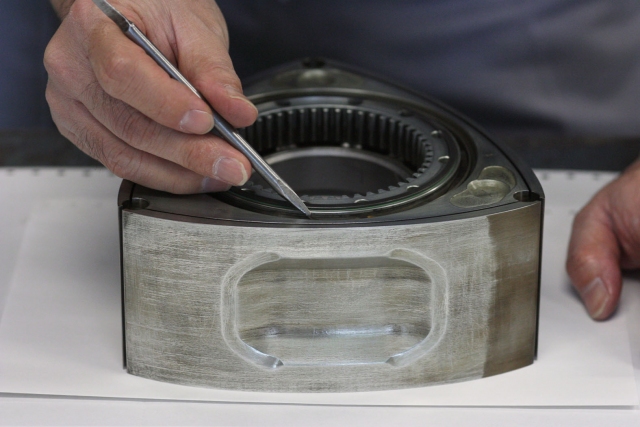For decades the abbreviation “RE” in Mazda parlance stood for “Rotary Engine.” However, if the Mazda patents for a new rotary that appeared last week have anything to say about it, “RE” might take on a whole new meaning.
Two new patents filed by Mazda Motor Corporation showed up on the US Patent and Trademark Office website last week, according to Autoblog. One shows a rotary engine being used as a “Range Extender” in a hybrid system. In this setup, an electric motor powers the front wheels, while a rear-mounted, single-rotor engine powers a generator that charges a lithium-ion battery pack. The setup is similar to a rotary- and battery-powered Mazda Demio concept shown in 2015.
The other patent adds fuel-saving technologies to the rotary, like an automatic start-stop function popular on many petrol engines today. With the rotary design, though, there are some additional challenges. The rotor has to be clocked to a certain orientation, so that exhaust gases don’t escape through the intake, and n additional sparkplug is added to burn excess vapors.
Though it’s not strictly a performance engine, the patents are encouraging. For one, the setup balances out some of the rotary engine’s drawbacks. Electric motors have instantaneous torque, and a hybrid system promises improved fuel economy. This could go a long way to making a future rotary more acceptable to both customers and regulatory agencies. Perhaps more importantly, though, is that the patents prove that Mazda engineers are still working on the rotary, no matter form it takes.
Images courtesy of Mazda.








Hmmmmm………Mark my words Mazda…….I’m watching you, 24/7, 365
You can bet that there will be some interesting refinements in the Rotary engines future… Glad to see it is not just a page in history…
This makes a lot of sense actually and Im surprised it didn’t come sooner. Rotary’s like constant speed and generators like constant speed. rotary’s are most efficient at constant speed and you need constant speed on a gen to produce constant voltage. It can rev higher than a normal engine in a much smaller package, one that is probably smaller that a 8.8 rear end. They dont have to run all the time if the car is powered off batteries with a elec motor thus helping with the reliability problem. Bout time.
Big or small, the rotory ICE is not the most efficient engine. A mini-turbine generating system makes most sense for a self-charging and/or hybrid EV.
A turbine system would likely be smaller, lighter and would efficiently run on an assortment of fuel options. Gasoline, diesel, alcohol, kerosine, veggie oil, etc. – whatever you have at hand. I think the auto industry needs to just let go of the old tech they are comfortable with.
i like the idea of a diesel-electric style hybrid system in cars (https://en.wikipedia.org/wiki/Diesel-electric_transmission), but if i understand correctly, rotary’s drink fuel pretty heavily, so it dosent seem like it would make sense efficiency-wise to use on as a generator. even if its running at its most efficient rpm, wouldnt something like the skyactiv 1.3 be a much better choice?
or even a sky-d 2.2
Fun fact: The only rotary-engined car I’ve driven was Audi’s A1 e-tron prototype, which like the Demio used a tiny rotary range extender, in this case mounted under the luggage area at the back. It started up soon after I got in, as the car was on fairly low charge, but really it was little louder than a pure battery electric vehicle – the rotary is so smooth that noise and vibration were very low indeed. Would be interesting to see how Mazda applies the technology if it made it into production.
An awesome fit. Rotary engines are incredibly reliable and can be configured to be very fuel efficient, particularly if you’re only tuning for a steady rpm operating condition. Looking forward to seeing how the advancements made here will be re-applied to a performance rotary application down the road!
Takes a lot of fuel when accelerating, not so much on constant rpm